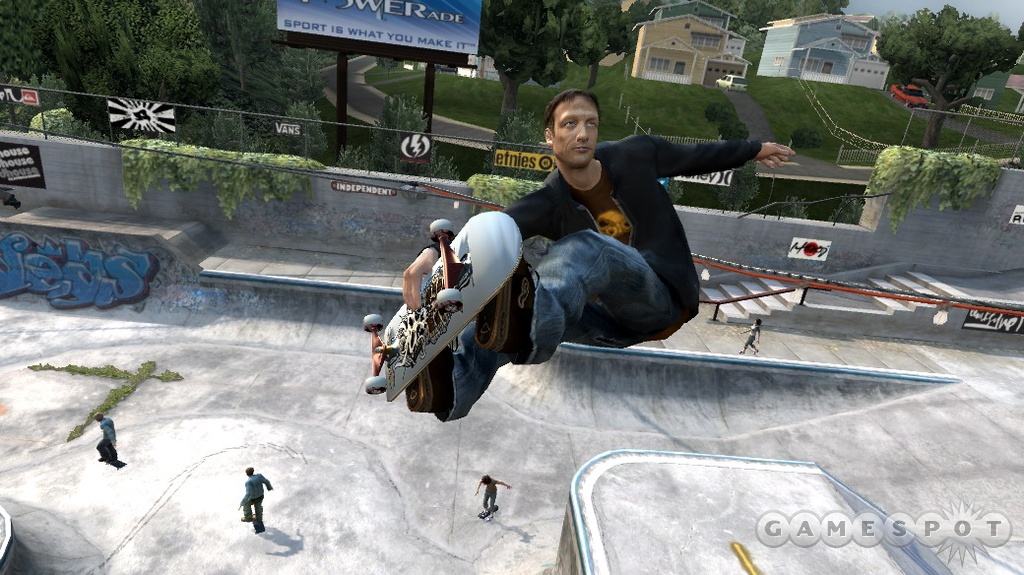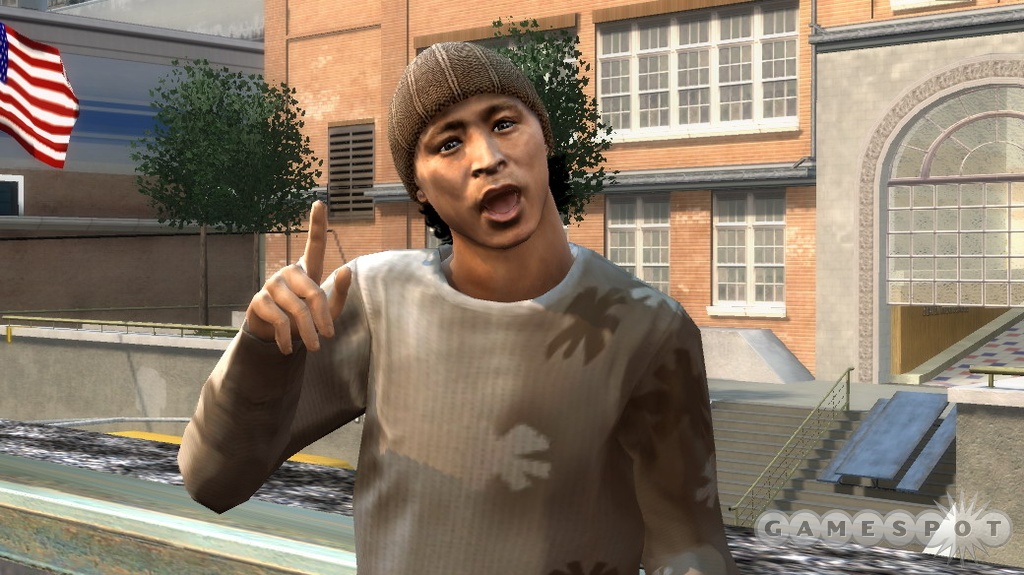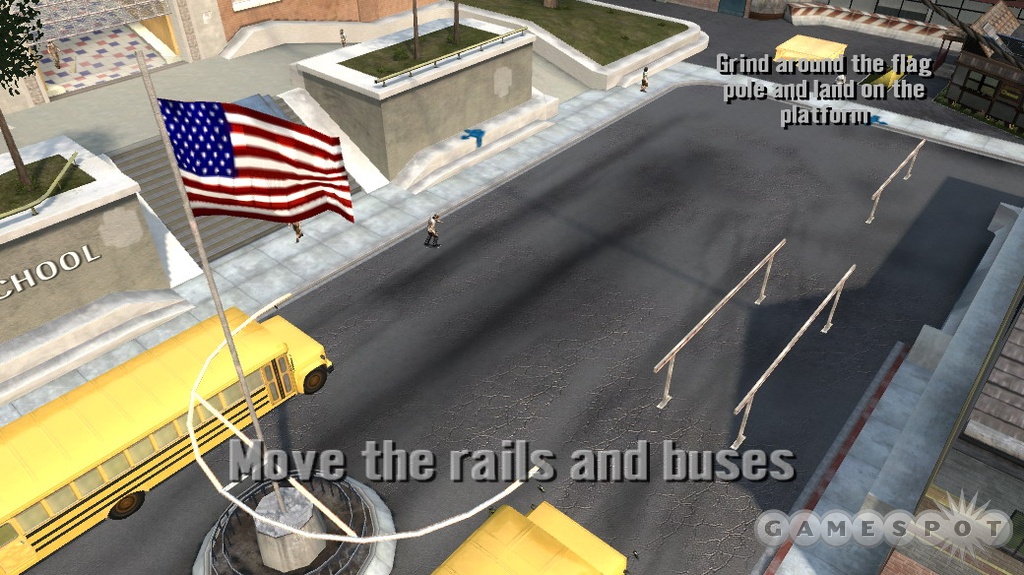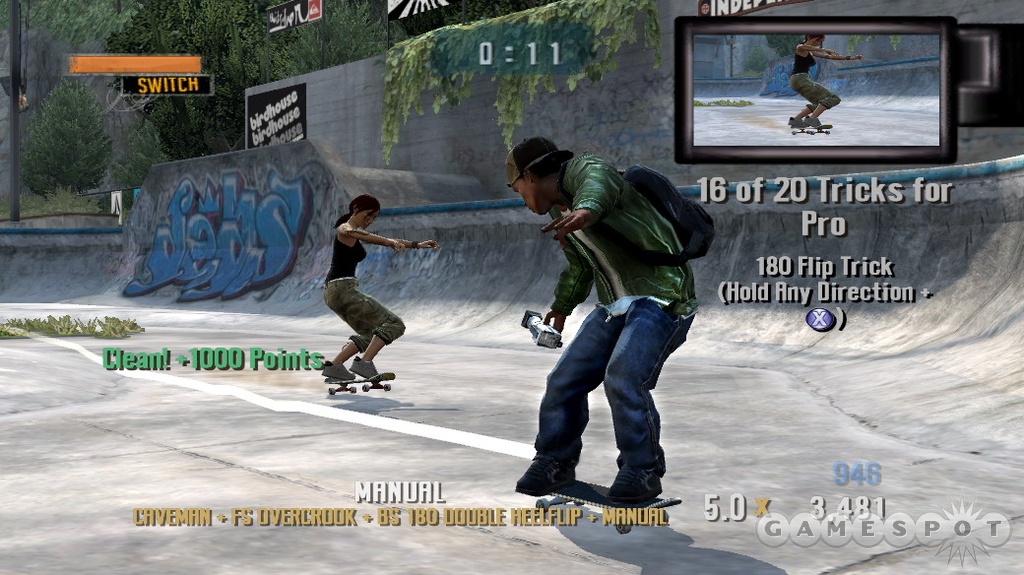Tony Hawk's Project 8 Hands-On
We try to grind our way into the top eight (or at least get as close as we can) in our hands-on look at the new Tony Hawk game.
Neversoft is rightfully proud of its brand-new motion-capture facility. The famed developer of the equally famous Tony Hawk series has built a state-of-the-art mo-cap studio located in a cavernous warehouse section of its new digs in Southern California. It's not surprising that a big-time developer would have this kind of technology available in-house. What is surprising is how the Tony Hawk series, which has prided itself on being a remarkably accurate representation of skateboarding tricks and culture, has gone so long without motion capture. And this is just one of the new things we learned about the upcoming Tony Hawk's Project 8 during a recent trip down to SoCal to visit the Neversoft bunch and check out the game for ourselves.

The previous Tony Hawk game, American Wasteland, was the first TH game to use motion capture of any kind; the cutscenes in the game used the technology. While THAW for the Xbox 360 was more or less a port of the Xbox and PlayStation 2 version of the game, the Xbox 360 and PlayStation 3 versions of Project 8 have been built from the ground up specifically to harness the power of the next-gen consoles. With that much processing power and memory on hand, one of the first orders of business was to make sure that practically any move or trick found in the game was first captured in real life using the mo-cap studios.
What that entailed was approximately 63 days of mo-cap, which started at the beginning of the development cycle for Project 8 in February 2006. Along with in-house staff posing as amateur skaters and pedestrians, which you often (literally) run into when roaming the open world of Project 8, every pro skater featured in the game spent some time in the studio being filmed performing not only a number of "standard" tricks and skating moves, but also signature styles that are unique to that skater. One particularly dedicated pro, Rodney Mullen, spent a total of three days in the studio fine-tuning his tricks for the (multiple) cameras that were recording his every move.
In addition to dressing the skaters in the requisite spandex and light-capturing balls getup that you might be used to seeing pro ball players don once a year for video game mo-cap sessions, the Project 8 folks even went so far as to mo-cap the skateboards themselves. Not only were the bottoms of the boards fitted with the balls, but special strips were attached to the trucks. As a result, subtle details such as board and truck flex are captured in loving detail thanks to the wonders of mo-cap magic.
All of this technology and detail is designed to make the tricks in Project 8 look more realistic than ever. Whereas before, every trick was hand-animated by the enormously talented Neversoft art team, now, each trick will be based on the real-life move that was captured in the studio. That doesn't mean the animation guys can just take the rest of the year off, however; the job of tying the trick animations together so they flow in a realistic and believable manner is a key element to ensuring that all of the captured tricks play true in the game.
The focus on the moves and physics of skaters and their boards is indicative of the development mind-set behind Project 8. Departing from the narrative-heavy approaches found in the past few Tony Hawk games, Project 8 is focused squarely on the tricks. There's still a story in Project 8--Tony Hawk's looking to assemble a team of the eight best amateur skaters in the world, and your job will be not just to make it on the team, but to rise to the number one position--but, in the end, Project 8 is all about getting on your board and showing what you can do.

To show off your skills, a slew of different challenge types will be available to you as you scoot around the Project 8 urban and suburban environments. These include spot challenges, which are set up throughout the world, and you must meet various requirements to pass them, such as grinding a rail for a certain length or acquiring a huge amount of air in big-air challenges. Unlike instanced challenges, spot challenges are available at any time--to initiate a grind challenge, for instance, you simply start the grind near the starting point. Other challenges available in the game, such as puzzle challenges, require you to get from a starting point to an end point, and will let you move around a number of objects to create a "path." One puzzle challenge required us to maneuver through a number of rails and school buses, before grinding quickly around a flag pole and eventually onto a wooden crate. Puzzle challenges will test not only your trick skills, but your ability to lay out the objects available to you in such a way as to pass the challenge. It's not exactly a park creator (which won't be featured in Project 8), but it's pretty fun nonetheless.
Finally, we have to mention the bail challenges scattered throughout the world, which were among our favorite challenges. Here, the idea is to grab some air and then launch your skater off the board. The game's Havok physics engine kicks in, and your player flops through the air, bouncing off every tree, column, staircase, and bush he or she hits on the way down. The ragdoll physics are hilariously exaggerated here, and if nothing else, this mode is good for a few laughs.
An essential ingredient for any trick-based game is finding a balance between making the game appealing to those new to the series while still appeasing vets who are always looking for new and exciting ways to punish their fingers. Project 8 addresses this by assigning skill levels to various challenges in the game--am (for amateur), pro, and sick, which you can think of as bronze, silver, and gold medal equivalents. Reaching amateur level for most of the early challenges in the game should be a breeze, even for those new to skateboarding games. Achieving "pro" level on most challenges will require some dedication, while "sick" level is going to take some real cojones. Producers estimate that achieving sick ratings on all the challenges found in the game (and thus earning the "sick" ending), will take you roughly 20 to 25 hours of game time, depending on your skills, a far cry from the two- to four-hour sprints that made up the recent Tony Hawk entries.

As is the case with many next-generation games, Tony Hawk's controls make liberal use of the analog sticks. Pushing the left stick forward while in the air, for example, will pull off a kick flip with the board, and there are many more variations you can pull off using both analog sticks. The coolest example of the new analog controls, and an entirely new feature in the game, is the "nail the trick" feature. It essentially lets you create your own trick on the fly, and you can access "nail the trick" mode either by entering specific challenges of the same name or by clicking the two analog sticks at any time.
In this mode, the game will slow down, and the camera will shift to the side, focusing on your board and your feet. Each analog stick controls one of your feet--the left stick controls the foot closest to the left edge of your screen, while the right stick controls the foot closest to the right. As you fly through midair, you can move either foot up or down to flip your board as you go, opening a wealth of base and branching tricks that are initiated depending on whether the board is tape-up or trucks-up. As the board flips through the air, it essentially becomes its own physics object and will react realistically with your feet depending on which way you move the sticks. While the developers initially had "nail the trick" tied only to specific challenges, they liked the mode so much they decided to make it part of the actual control scheme, letting you initiate the mode whenever you wish. In another bit of smart design, tricks pulled off in this mode will also count toward your combo scores, which should make it one more weapon in the arsenal of the Tony Hawk hardcore who regularly rack up million-point combos.
As you skate your way around the world in Project 8, every trick you pull off will go toward your overall progression as a skater. Grind for long enough, and your proficiency at grinding will advance--make enough big-air jumps, and your skill will go up in that area. If you want, you can check out a detailed look at your skater's stats and see exactly how much you have to do to get to advance in any particular skill area (just 838 more feet of grinds before getting that next level!)
Graphically, Tony Hawk is looking sharp. Skater models--whether they are scans of real-life pros (which are, for all intents and purposes, indistinguishable from their real-life counterparts) or created skaters we got to mess around with during the demo--are vibrant looking and animate well, and there's very little in the way of frame rate or animation stuttering to complain about. Things may be mo-capped out the wazoo in Project 8, but the animations themselves seem smooth and silky. In addition, the environments that you skate through are lively and interesting looking, with plenty of objects to interact with, lots of elevation changes to take advantage of, and loads of peds to mow down in your quest for skating glory. The game's sound deserves some special mention as well--we liked how the sound would change depending on what kind of surface we were skating over, be it asphalt, grass, or a rubberized pool cover.

Game modes in Project 8 will include the career mode, create a skater (which we didn't get to check out, unfortunately), and online and split-screen multiplayer. On the online side, Project 8 will include a number of leaderboards for various challenges found in the game, as well as support for up to eight virtual skaters online. One new multiplayer game type we learned about is dubbed "walls." Here, as you skate along, you'll be trailed by a line that creates walls. Should one of your opponents hit this wall, you'll earn a "frag," the ultimate goal being to box in your opponents (sort of like a skating version of the old arcade geometry battle Qix).
With its old-school focus on tricks and challenges, a revamped control scheme, and some cool new features, Tony Hawk's Project 8 is looking like an appealing mix of the old and the new. We'll have more on the game leading up to its release this fall, as well as a full review once the game hits store shelves.
Got a news tip or want to contact us directly? Email news@gamespot.com
Join the conversation